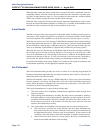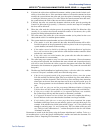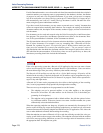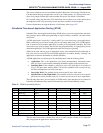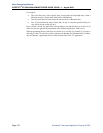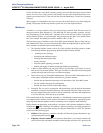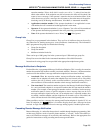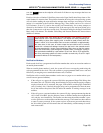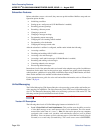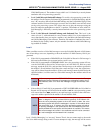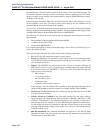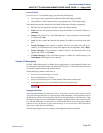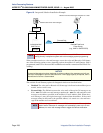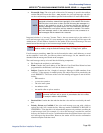
Voice Processing Features
INTER-TEL
®
CS-5200/5400 ADMINISTRATOR GUIDE, ISSUE 1.1 – August 2005
Page 282 Primary and Alternate Notification
Primary and Alternate Notification
Each mailbox can have a Primary and/or an Alternate notification cascade of numbers. The
notification numbers are programmed to be accessed during specific days and times.
The Voice Mail system monitors subscriber mailboxes continuously. During monitoring, if new
messages have been received, the system will check to see if Primary notification is turned on.
If it is, the system will check the day and time programming. If the current time is within the
programmed notification day and time, the Voice Mail system will make the notification call(s)
to the numbers in the Primary Notification cascade. If Primary Notification is turned off or if
the day or time does not match, the Voice Mail system will immediately make the same check
for Alternate Notification and possibly place calls to the numbers in the Alternate Notification
cascade.
When the voice processing system makes a notification call, it moves through the appropriate
notification cascade level by level as determined by the notification and retry programming
described below. When the system reaches the last level in the cascade, it will return to level 1
and begin again, if necessary.
If the system is not able to place the call within the parameters of the programmed notification
day and time (due to busy facilities or invalid programming), the mailbox will receive a mes-
sage stating that notification could not be completed (the mailbox owner will hear the message
next time he or she accesses the mailbox.)
The number of calls that the voice processing system can process simultaneously is determined
by the Maximum Number of Outgoing Calls flag. It defaults to 2, but can be programmed to
use all of the enabled voice processing system voice channels.
Message Flags
When the mailbox is being programmed for remote notification, message notification can be
set to place the notification call when any message is received or only when priority messages
are received. (This defaults to “All Messages.”) Another mailbox flag, called “Call For Each
New Message,” determines when the voice processing system will attempt to make the notifi-
cation call when more than one message is waiting to be heard:
• If the Call For Each New Message flag is enabled, the voice processing system will
attempt immediate notification each time a new message (or priority message, depend-
ing on the option selected) is received, regardless of the status of the applicable retry
timer. If a retry is in progress, it will place the call to the number on the cascade table
that would have received the retry call, as described below. (For example, if the voice
processing system was on level 3 of a cascade, attempting retries, it will not start over
again at level 1. It will place the call to level 3.)
• If the Call For Each New Message flag is disabled, new messages will not generate a
remote notification attempt until the Subscriber has logged on and listened to the wait-
ing message(s). (However, retry calls will be attempted if the applicable retry timer
expires, as described below.)
Retry Call Attempts
The mailbox can be programmed to retry notification calls when it encounters a busy trunk or
trunk group. Each cascade level can be programmed with a Number of Call Attempts value of
1–1000 calls.
If the mailbox user accesses the mailbox between the time the message is received and when
remote notification is successful, the system will stop attempting remote notification. It is
assumed that the mailbox user listened to the message when the mailbox was accessed. How-



